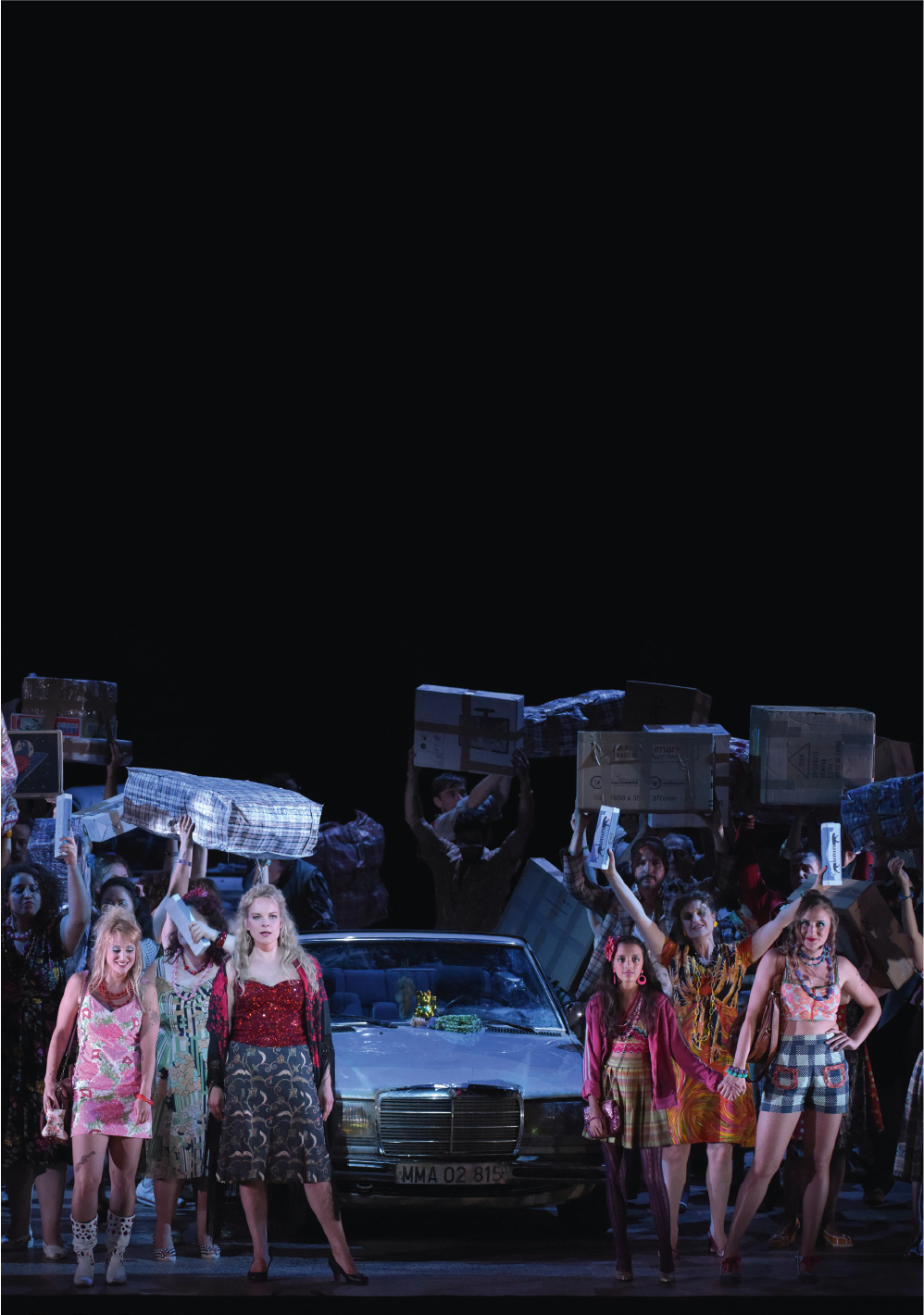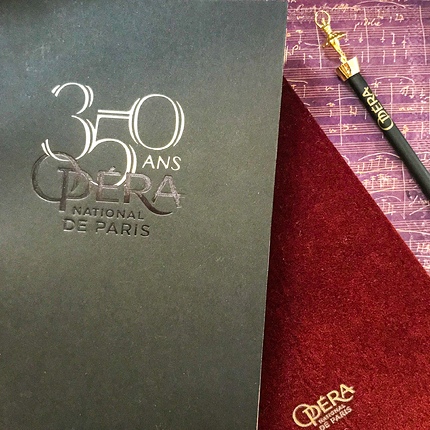Synopsis
Two works by Stravinsky, both written for dance, come together: one caused a scandal at its first performance, the other marked the beginning of a new collaboration with George Balanchine. Agon has no scenario other than the score and translates into pure, abstract dance with a linear geometric quality that echoes the world’s title. In her version of The Rite of Spring, Pina Bausch urges the score’s rhythmic power to burst forth. On an earth‑covered stage, possessed by an intense energy, the dancers engage in a deeply‑moving ritual. Alongside these two masterpieces, Saburo Teshigawara has been commissioned to create a new work giving substance to a profound, organic and poetic language on Esa‑Pekka Salonen’s haunting Violin Concerto.
Duration : 2h10 with 2 intervals
Artists
Creative team
Cast
- Tuesday 24 October 2017 at 19:30
- Wednesday 25 October 2017 at 19:30
- Thursday 26 October 2017 at 19:30
- Friday 27 October 2017 at 19:30
- Saturday 28 October 2017 at 19:30
- Tuesday 31 October 2017 at 19:30
- Thursday 02 November 2017 at 19:30
- Friday 03 November 2017 at 19:30
- Saturday 04 November 2017 at 19:30
- Tuesday 07 November 2017 at 19:30
- Saturday 11 November 2017 at 19:30
- Sunday 12 November 2017 at 14:30
- Tuesday 14 November 2017 at 19:30
- Thursday 16 November 2017 at 19:30
Latest update 16 November 2017, cast is likely to change.
Latest update 16 November 2017, cast is likely to change.
Latest update 16 November 2017, cast is likely to change.
Latest update 16 November 2017, cast is likely to change.
Latest update 16 November 2017, cast is likely to change.
Latest update 16 November 2017, cast is likely to change.
Latest update 16 November 2017, cast is likely to change.
Latest update 16 November 2017, cast is likely to change.
Latest update 16 November 2017, cast is likely to change.
Latest update 16 November 2017, cast is likely to change.
Latest update 16 November 2017, cast is likely to change.
Latest update 16 November 2017, cast is likely to change.
Latest update 16 November 2017, cast is likely to change.
Latest update 16 November 2017, cast is likely to change.
Creative team
Cast
- Tuesday 24 October 2017 at 19:30
- Wednesday 25 October 2017 at 19:30
- Thursday 26 October 2017 at 19:30
- Friday 27 October 2017 at 19:30
- Saturday 28 October 2017 at 19:30
- Tuesday 31 October 2017 at 19:30
- Thursday 02 November 2017 at 19:30
- Friday 03 November 2017 at 19:30
- Saturday 04 November 2017 at 19:30
- Tuesday 07 November 2017 at 19:30
- Saturday 11 November 2017 at 19:30
- Sunday 12 November 2017 at 14:30
- Tuesday 14 November 2017 at 19:30
- Thursday 16 November 2017 at 19:30
Latest update 16 November 2017, cast is likely to change.
Latest update 16 November 2017, cast is likely to change.
Latest update 16 November 2017, cast is likely to change.
Latest update 16 November 2017, cast is likely to change.
Latest update 16 November 2017, cast is likely to change.
Latest update 16 November 2017, cast is likely to change.
Latest update 16 November 2017, cast is likely to change.
Latest update 16 November 2017, cast is likely to change.
Latest update 16 November 2017, cast is likely to change.
Latest update 16 November 2017, cast is likely to change.
Latest update 16 November 2017, cast is likely to change.
Latest update 16 November 2017, cast is likely to change.
Latest update 16 November 2017, cast is likely to change.
Latest update 16 November 2017, cast is likely to change.
Creative team
Cast
- Tuesday 24 October 2017 at 19:30
- Wednesday 25 October 2017 at 19:30
- Thursday 26 October 2017 at 19:30
- Friday 27 October 2017 at 19:30
- Saturday 28 October 2017 at 19:30
- Tuesday 31 October 2017 at 19:30
- Thursday 02 November 2017 at 19:30
- Friday 03 November 2017 at 19:30
- Saturday 04 November 2017 at 19:30
- Tuesday 07 November 2017 at 19:30
- Saturday 11 November 2017 at 19:30
- Sunday 12 November 2017 at 14:30
- Tuesday 14 November 2017 at 19:30
- Thursday 16 November 2017 at 19:30
Latest update 16 November 2017, cast is likely to change.
Latest update 16 November 2017, cast is likely to change.
Latest update 16 November 2017, cast is likely to change.
Latest update 16 November 2017, cast is likely to change.
Latest update 16 November 2017, cast is likely to change.
Latest update 16 November 2017, cast is likely to change.
Latest update 16 November 2017, cast is likely to change.
Latest update 16 November 2017, cast is likely to change.
Latest update 16 November 2017, cast is likely to change.
Latest update 16 November 2017, cast is likely to change.
Latest update 16 November 2017, cast is likely to change.
Latest update 16 November 2017, cast is likely to change.
Latest update 16 November 2017, cast is likely to change.
Latest update 16 November 2017, cast is likely to change.
Media
Access and services
Palais Garnier
Place de l'Opéra
75009 Paris
Public transport
Underground Opéra (lignes 3, 7 et 8), Chaussée d’Antin (lignes 7 et 9), Madeleine (lignes 8 et 14), Auber (RER A)
Bus 20, 21, 27, 29, 32, 45, 52, 66, 68, 95, N15, N16
Calculate my routeAt the Palais Garnier, buy €10 tickets for seats in the 6th category (very limited visibility, two tickets maximum per person) on the day of the performance at the Box offices.
In both our venues, discounted tickets are sold at the box offices from 30 minutes before the show:
- €25 tickets for under-28s, unemployed people (with documentary proof less than 3 months old) and senior citizens over 65 with non-taxable income (proof of tax exemption for the current year required)
- €40 tickets for senior citizens over 65
Get samples of the operas and ballets at the Paris Opera gift shops: programmes, books, recordings, and also stationery, jewellery, shirts, homeware and honey from Paris Opera.
Palais Garnier
- Every day from 10:30 a.m. to 6 p.m. and until performances end
- Get in from Place de l’Opéra or from within the theatre’s public areas
- For more information: +33 1 53 43 03 97
Online
Palais Garnier
Place de l'Opéra
75009 Paris
Public transport
Underground Opéra (lignes 3, 7 et 8), Chaussée d’Antin (lignes 7 et 9), Madeleine (lignes 8 et 14), Auber (RER A)
Bus 20, 21, 27, 29, 32, 45, 52, 66, 68, 95, N15, N16
Calculate my routeAt the Palais Garnier, buy €10 tickets for seats in the 6th category (very limited visibility, two tickets maximum per person) on the day of the performance at the Box offices.
In both our venues, discounted tickets are sold at the box offices from 30 minutes before the show:
- €25 tickets for under-28s, unemployed people (with documentary proof less than 3 months old) and senior citizens over 65 with non-taxable income (proof of tax exemption for the current year required)
- €40 tickets for senior citizens over 65
Get samples of the operas and ballets at the Paris Opera gift shops: programmes, books, recordings, and also stationery, jewellery, shirts, homeware and honey from Paris Opera.
Palais Garnier
- Every day from 10:30 a.m. to 6 p.m. and until performances end
- Get in from Place de l’Opéra or from within the theatre’s public areas
- For more information: +33 1 53 43 03 97




































































































































